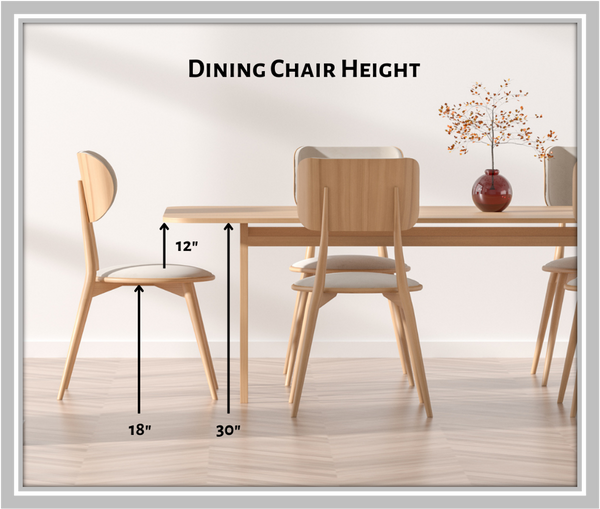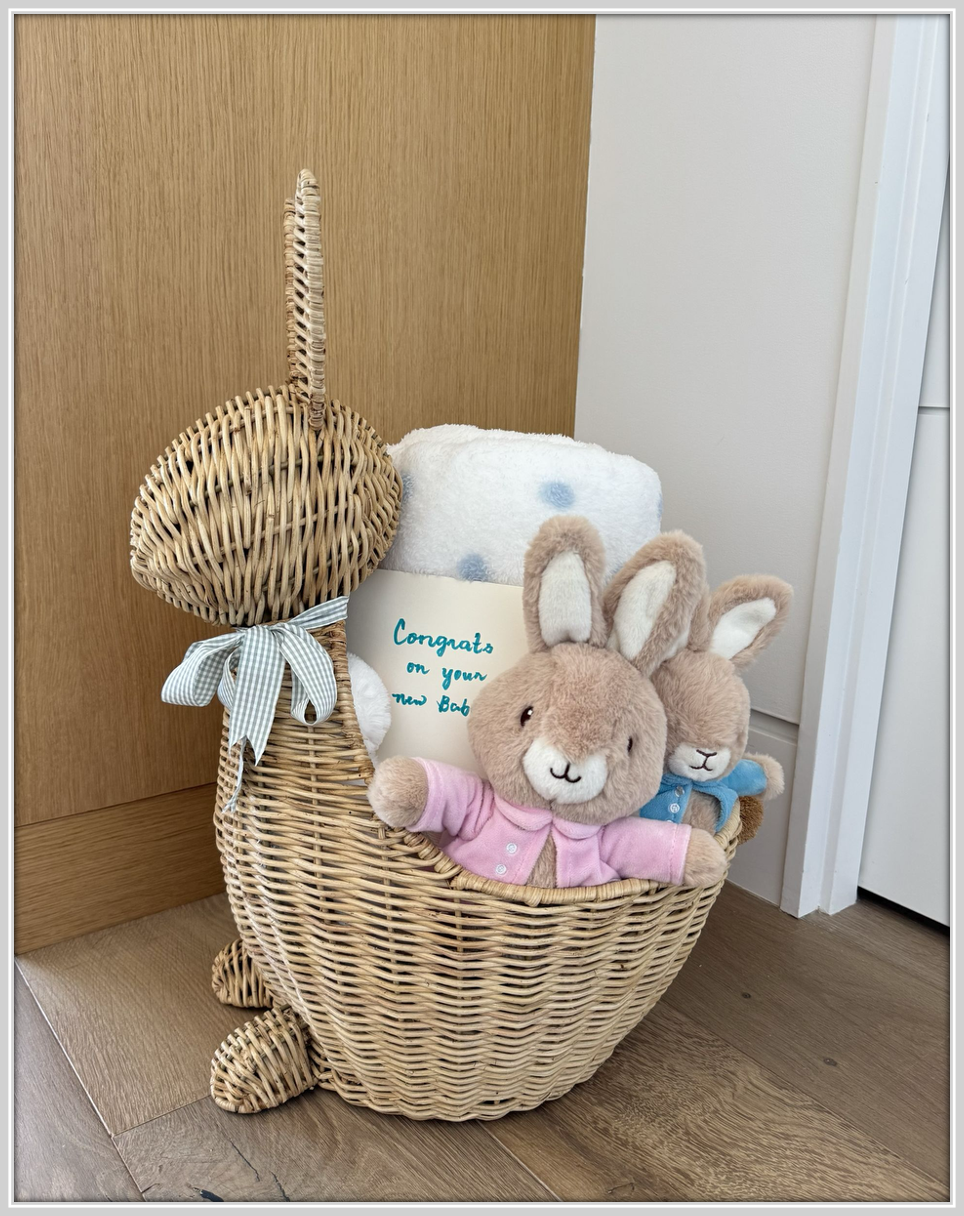All Discounted Items are Final Sale

Dining isn’t just a necessity – when done well, it’s also an experience. And if you’re looking to create a space that’s comfortable and inviting while also speaking to your personal design vibe, we need to talk about chairs.
Selecting dining chairs isn’t just a design preference. There are many technical aspects you’ll want to consider as well, including the height, size and width of your seats. Using the wrong chairs in your space can throw off your design, while also making guests uncomfortable or frustrated – both decidedly unappetizing prospects. In this guide, we'll help you navigate the complexities of dining chair dimensions and help you create the perfect sitting situation for your needs.
Dining chair-back height can vary from 30 to 44 inches. This number can certainly vary depending on the style of chair you've chosen, and of course, the height of the chair seat.
Dining chair seat heights typically range from 17 to 19 inches.The relationship between seat height and chair-back height in dining chairs is crucial to ensure a comfortable and ergonomic dining experience. Finding the right balance between these two dimensions is essential for proper posture and support during meals. Keep in mind:
Let’s explore the three common types of seating: standard dining table height, standard counter height, and standard bar height.

Source: KOUBOO
Standard dining tables measure around 28 to 30 inches tall. To choose the right chairs for this type table, you'll want to keep a 12-14 inch gap between the standard dining tabletop and the seat of the dining chair. This means the seat height of your chairs will typically measure 16-18 inches.
This 12-14 inch (25-30 cm) gap between the table's surface and the chair or stool seat gives diners enough leg and elbow room — and prevents accidental (and very awkward) knee bumping. To determine the distance, measure from the bottom of the tabletop (or apron, if the table has one) and the height of the chair’s seat. Then subtract the latter from the former.
For instance, if the bottom of your tabletop is 30 inches tall and your chair seat is 18 inches high, you'll have a 12-inch gap, which is optimal for comfort.


Source: Designing Idea
Typical counter-height dining tables are 34 – 36 inches tall(just like a countertop!), so you’ll obviously need stools to ensure an ergonomic dining experience.
Despite the taller format, you’ll want to shoot for that 12 – 14-inch gapbetween the bottom of the table and the seat of your stool. This means a comfortable stool will have a seat that’s 22 – 24 inches off the floor.


Source: Happily Inspired
A bar-height dining table typically ranges from 40 – 42 inches. Using the same math, that means you’ll want bar stools with seats that sit at about 28 – 30 inches from the floor. If you’re looking for an elevateddining experience, raise the bar!
While counter- and bar-height dining stools do not allow diners to place their feet comfortably on the floor, you might want to consider stools that feature a footrest or bar to keep your family and guests comfortable at the table.


Source: KOUBOO
When measuring the width of your dining chairs, remember that you’ll want at least 6” between each chair and about 24” of space total for each place at the table. Like height, the width of your dining chairs is an important considering when completing your set – both for form and functionality. You’ll want chairs that are both wide enough to be comfortable and that fit the number of chairs necessary comfortable around the table.
That means, if your chair is 20” wide, you’ll need about 32” of space per chair, as you’ll want 6” on either side of the chair. If your chairs are 18” wide, plan on 30” of space. For a 96-inch rectangular table, you’ll be able to fit three chairs along each side and one at each head, making it comfortable for eight diners.
On average, most dining chairs are between 15” and 18” inches deep, allowing diners to sit comfortably upright without being swallowed by the chair. The depth of your dining chairs really comes down to personal preference and the size of your dining room or space.
That said, you’ll certainly want to consider your dining space when determining your dining chair depth, as it’s important to preserve space for people to walk behind a chair or open a cabinet near the table.
As a general rule, you’ll want at least 36” between the ends of your table and any walls or furniture within the space – assuming you select a chair of “standard” depth. If you opt for deeper seat, measure the chair’s depth and make sure you add any additional inches necessary to that 36” mark. For example, if your dining chair is 20” deep, that’s 2” deeper than a “standard” chair. So keep at least 38” between the table and any walls or furniture.
Love the King Arthur vibes of a round table? Or are you more square? Whatever the case, when it comes to choosing dining chairs, it's important to consider the shape and size of your table and how many people you want to accommodate. The following guide offers seating recommendations for popular table shapes and sizes.

Rectangular tables are classic, versatile and work well in most spaces.When considering how many chairs to buy, keep in mind that many rectangular tables include extra leaves to elongate the table. So if you’re planning to entertain more diners at any given point, you may want to consider purchasing enough chairs to fit the table at its lengthiest – and, of course, you’ll want to find chairs that stack or are otherwise easy to store if they won’t be gracing your table on a daily basis.
 Square tables create a more intimate experience, since diners will typically be closer to all their tablemates. Depending on the size of your square table, you may be able to fit two or three chairs per table side, giving you the a roundtable vibe with a decidedly modern shape.
Square tables create a more intimate experience, since diners will typically be closer to all their tablemates. Depending on the size of your square table, you may be able to fit two or three chairs per table side, giving you the a roundtable vibe with a decidedly modern shape.

Round tables encourage conversation and provide a relaxing aesthetic – so opt for chairs that carry that vibe. With no definite “sides” on a round table, the number of chairs you’ll be able to accommodate will depend solely on the table’s circumference (see chart).

Oval tables blend the best of rectangular and round table designs. While most oval tables will accommodate the same number of chairs as a rectangular table of the same length, a particularly wide oval may allow you two “head-
When choosing dining chairs, keep these additional considerations in mind:
While many of these will depend widely on your personal style, several may impact the functionality of your dining system. For example, if you opt for upholstery or cushioned seats, this may impact the space between the bottom of your tabletop and the top of your dining chair’s seat because cushions and upholstery often compress under weight.
Additionally, personal considerations – like the size and weight of your family members or regular guests– can also impact your decision, so make sure you know the technical capabilities of any chair you’re considering.
Choosing the right dining chairs or stools not only enhances your design vibe, but it can also help you create a space that’s inviting, comfortable and decidedly stylish. With your new knowledge in hand, check out our collection of handmade, quality dining chairs and stools that are sure to elevate your space for years to come.

Explore 10+ beach house gift ideas from Kouboo - elegant coastal décor and accessories made for relaxed, beachside living.

Discover 10+ budget-friendly fall decor ideas to give your home a warm, cozy vibe. From DIY accents to affordable finds, bring autumn charm into every room without overspending.

Discover 10 clever kids’ room organization and storage ideas to keep toys, books, and clothes tidy. Stylish, practical solutions from Kouboo to remove clutter.